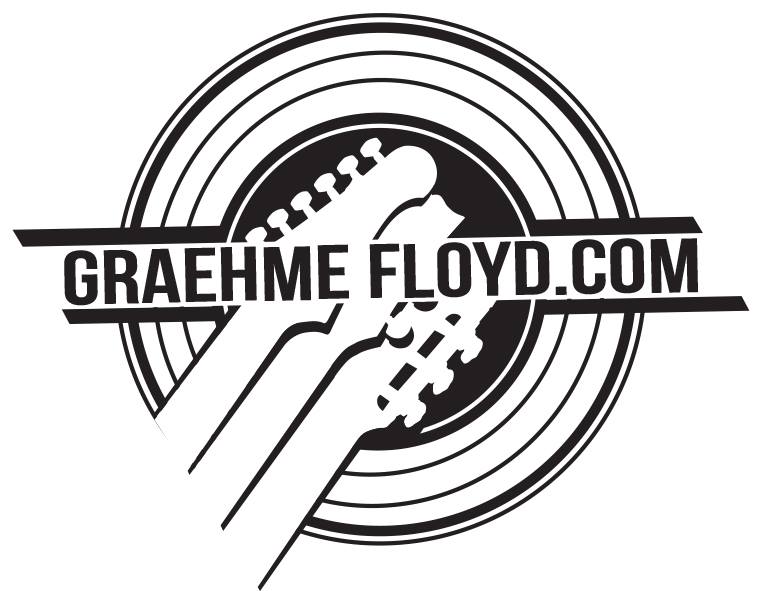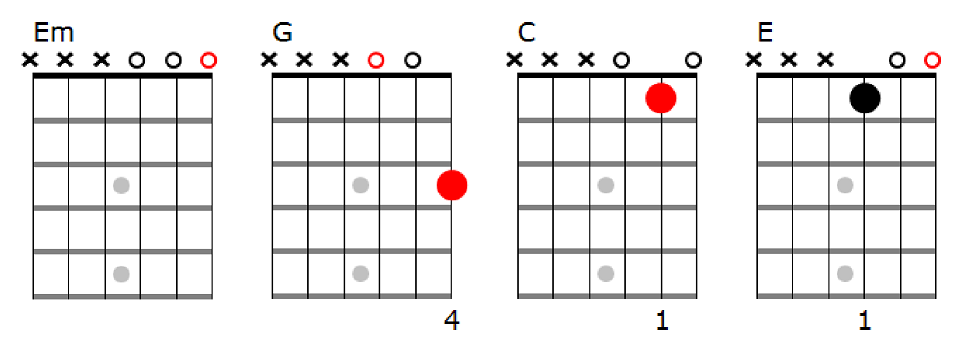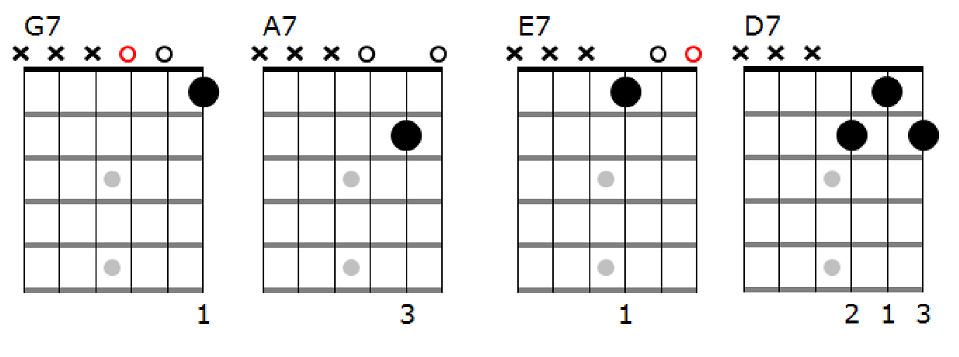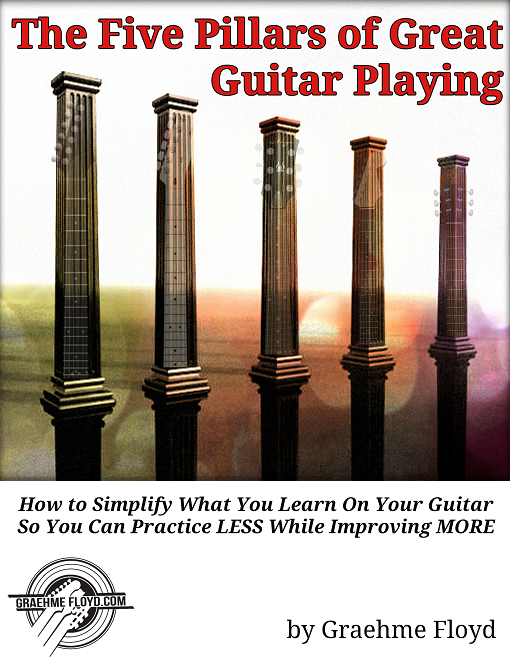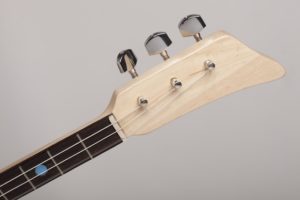 In this lesson, you will be learning the first eight 3-string chords that are the best to learn first when starting on the guitar.
In this lesson, you will be learning the first eight 3-string chords that are the best to learn first when starting on the guitar.
If you haven’t already seen it, I recommend reading through The Best Guitar Chords to Learn When First Starting to Play The Guitar. In it I explain why learning 3-string chords is so effective for beginner guitar players and why, on average, beginners are able to learn and play chords using this method in about 20 minutes.
If you’ve read the article already, or you would just rather dive in and learn now, you’ll find the chords below.
Here is the first set of 3-string chords that you should learn to play on your guitar:
| Download the 3-String Chords Quick Sheet for this lesson. |
If you look closely, you’ll see that all of these 3-string chords are played on the top three strings of your guitar, specifically the 1st, 2nd, and 3rd strings.
Let’s take a look at each one individually to see how they are played:
E Minor
No fingers, strings, or frets to press.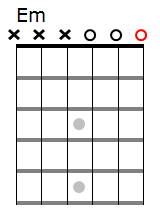
This is the easiest chord in the group and probably the easiest chord to play on your guitar!
You don’t have to hold any strings down at all, just play the top three strings on your guitar. That’s it!
Some of my students tend to refer this chord as being a ‘freebie’ or the ‘lazy chord’ because it is just so easy to play. But, don’t forget to remember its name as you will be seeing it in a lot of different songs and progressions in the future.
G Major
The 4th finger plays the 1st string holding the 3rd fret.
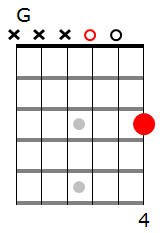 When you look closely a G Major, you’ll notice that I’ve suggested you use the 4th finger to play the 1st string. Now, this may seem a little string to use the 4th finger, as it would be much easier to use the 1st or 2nd fingers to get the job done. But, there is reason for using the 4th finger.
When you look closely a G Major, you’ll notice that I’ve suggested you use the 4th finger to play the 1st string. Now, this may seem a little string to use the 4th finger, as it would be much easier to use the 1st or 2nd fingers to get the job done. But, there is reason for using the 4th finger.
When you learn to play the larger 5 and 6-string versions of G Major, and indeed with many other chords, your fingers are going to be needed in particular places because of the stretch, reach, and complexity of those chords. Where you have place your 4th finger in the 3-string G Major chord is the same place it will be in the 6-string G Major chord! By building this habit into your playing now, you will be that much more prepared and ready to play the bigger chord when it is time to do so.
C Major
The 1st finger plays the 2nd string holding the 1st fret.
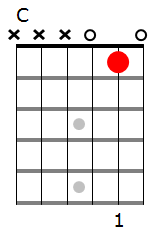 Be careful when playing C Major as the 1st finger has a habit of accidentally touching the 1st string. This will mute the 1st string and prevent it from ringing out properly.
Be careful when playing C Major as the 1st finger has a habit of accidentally touching the 1st string. This will mute the 1st string and prevent it from ringing out properly.
It is important to be able to hear each of the strings in your chord ringing out fully when playing your chords. To make sure that they are all ringing fully, play each string one at a time while holding your chord and listen to hear if they are ringing. If they aren’t, you will need to slightly adjust your fingers on the strings to make sure they aren’t affecting each other.
E Major
The 1st finger plays the 3rd string holding the 1st fret.
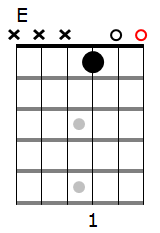 E Major is played in a similar way to the C Major you just learned above, however, this time the 1st finger will be placed on the 3rd string. As before, be careful not to accidentally mute out the open strings.
E Major is played in a similar way to the C Major you just learned above, however, this time the 1st finger will be placed on the 3rd string. As before, be careful not to accidentally mute out the open strings.
Also, notice how similar E Major is to the very first chord you learned here; E Minor. This is not a coincidence! The very fact that these two chords share the E should tell you that they are related in some way.
There will be a time when learning why chords are Major, Minor, or anything else will become extremely important, but for now, focus on knowing the chord’s names, where they are played, and actually being able to play them.
G7 (Dominant 7)
The 1st finger plays the 1st string holding the 1st fret.
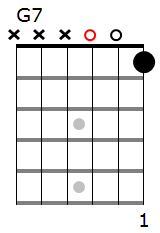 Even easier than C Major or E Major, G7 or G Dominant 7 is played by placing the 1st finger on the 1st fret of the 1st string and play the top three strings.
Even easier than C Major or E Major, G7 or G Dominant 7 is played by placing the 1st finger on the 1st fret of the 1st string and play the top three strings.
These 7th chords, specifically Dominant 7 chords, are very closely related to Major chords, however, they have a much more complex sound to them. When you play G7, notice that it sounds very tense; other words used to describe the sound could be crunchy, awkward, and harsh depending on how it sounds to you. Believe it or not, these chords are supposed to sound like this and are used this way in songs.
A7 (Dominant 7)
The 3rd finger plays the 2nd string holding the 2nd fret.
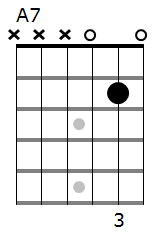 A7, or A Dominant 7, is very similar in position to C Major, however, you are using your 3rd finger on the 2nd string instead of the 1st finger. As with C Major, A7 runs the risk of a muted 1st string. Test the strings played with A7 to make sure that they all ring out fully.
A7, or A Dominant 7, is very similar in position to C Major, however, you are using your 3rd finger on the 2nd string instead of the 1st finger. As with C Major, A7 runs the risk of a muted 1st string. Test the strings played with A7 to make sure that they all ring out fully.
This is, of course, another awkward sounding Dominant 7 chord. A7 is the only A chord in this first group of chords, but there are many other types of A chords that you will be learning shortly.
E7 (Dominant 7)
The 1st finger plays the 3rd string holding the 1st fret.
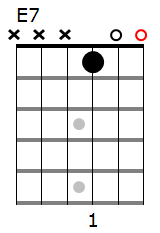 Looking closely at this chord, you’ll notice that this chord look identical to E Major, and for the moment, it is!
Looking closely at this chord, you’ll notice that this chord look identical to E Major, and for the moment, it is!
When you play E7 or E Dominant 7 on three strings, there aren’t enough strings to create the Dominant sound, however, once you add in a few more strings, later on, there will be a much bigger difference compared to E Major.
For the time being, if you see E7 play it this way – the same as E Major. It will still work correctly in your song or progression and you will learn the larger form in time.
D7 (Dominant 7)
The 2nd finger plays the 3rd string holding the 2nd fret.
The 1st finger plays the 2nd string holding the 1st fret.
The 3rd finger plays the 1st string holding the 2nd fret.
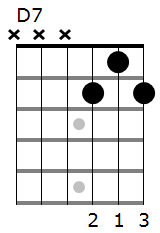 D Major or D Dominant 7 is the last and most difficult of the 3-string chords. It requires you to use three fingers of your fretting hand to play, compared to single finger in all the others. However, you will need to know this chord to be able to play the variety of different songs and progressions on your guitar.
D Major or D Dominant 7 is the last and most difficult of the 3-string chords. It requires you to use three fingers of your fretting hand to play, compared to single finger in all the others. However, you will need to know this chord to be able to play the variety of different songs and progressions on your guitar.
Make sure you follow the finger carefully as it will make the chord way easier to play when you use the fingering as shown.
Don’t worry if this particular chord takes some time to get down; you can still play a lot of songs without it, but if you will have even more open to you with D7 included.
That’s it for the first set of 3-string chords. There will be more coming soon, but before you start learning more chord shapes, you’re going to need to learn how to put them together to play songs.
